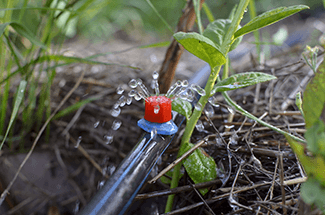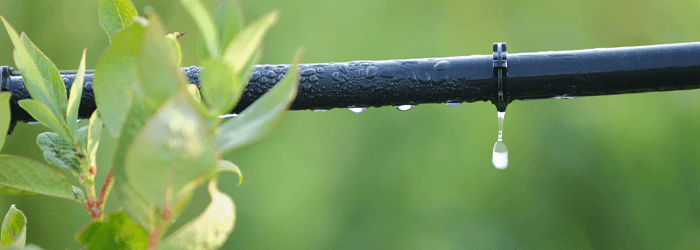Managing A Drip Irrigation System
You’ve just moved in to a brand new home that came complete with a landscape package, front and back. A drip irrigation system was provided for the trees and shrubs, and an underground sprinkler system was provided for the back lawn. You noticed this box mounted on the wall next to your electrical panel, but you don’t know if it’s part of your cable system, or what? Everything looks good.
A few months have passed, and before you know it, it is summer time. You’ve installed all the ceiling fans and window coverings, done some painting, and one day you noticed your landscape isn’t looking so good. Your plants have grown, but all of a sudden they’re discoloring, starting to wilt and look a bit stressed. You don’t know what’s wrong. You received this card from your builder listing all of the sub contractors that worked on your house, and way at the bottom the landscape company is listed. You give them a call and set up an appointment for a representative to come out to your house for an evaluation.
Why Adjust Your Irrigation Timer?
The first thing you are asked is, “Have you adjusted your time clock?” And your response is, “No, was I supposed to?” The answer is “yes”! And the reason why reflects a basic standard that applies in most irrigation scenarios. As your landscape trees and shrubs grow, as your lawn begins to mature, all require more water but less often. As plants grow, they develop larger and deeper root systems. The size of young plants’ root systems is equivalent to the size of the container they came out of. As they’re planted, their roots begin to develop and grow into the native soil. Light, frequent waters were okay after initial planting. But as plants grow, in order to get the water to where it’s needed, more water needs to be applied, but less frequently. Their roots are deeper, so the soil around those roots takes longer to dry out.
Watering Schedules

A typical schedule for newly planted shrubs (non-summer) would be to turn on the drippers every other day for thirty minutes. After three months, three times a week for forty five minutes and after six months, once a week for an hour (do you see the pattern developing?). For newly planted trees (since trees have a deeper root system, it’s always best to have a separate irrigation line), twice a week for an hour. Then after three months, water once a week for an hour and a half, and after six months, two hours every other week. As your trees and shrubs grow and develop larger root system, it’s a very good practice to move the drippers further away from the base of the plant, trying to stay as close to the drip line as possible, or the outer diameter of the plant.
For lawns, the same rule of thumb applies, keeping in mind most lawns have a relatively shallow root system compared to shrubs and trees, so a more frequent watering schedule is needed. Newly installed lawns might require a couple of times a day if planted from seed, and once or twice a day if planted from sod. Thereafter the same rule of thumb applies, only a shorter time frame. After one week, cut back to once a day for fifteen minutes. After two weeks, every other day for the same length of time, then after a month or once the lawn is established, three times a week should be sufficient. Then cut back to once a month during the winter dormancy period, or follow a regular schedule if a winter lawn is installed.
A typical watering schedule, days between watering, might look like the “Landscape Watering Guidelines” courtesy of the Arizona Municipal Water Users Association.
Proper Water Distribution
Also it’s important that you use the right drippers for the right job. The size of the dripper utilized should be proportional to the ultimate size of the plant. Low volume drippers (1 or 2 GPH – gallon per hour) should be utilized for your smaller shrubs or ground covers. High volume drippers (4 GPH) should be used for your trees or larger growing vines.
Also remember, in almost every case, for better or more equal distribution of water, more than one dripper should be used for each plant. Example might be two or three for shrubs, and four or six for trees.
For flowers and vegetables, there are countless numbers of drip watering devices, between all types of low volume sprinklers to soaker tubing, and everything in between. Please consult with your local lawn & garden center, or independent nursery professional, for a recommendation on the best type suited for your specific situation.
“What makes the desert beautiful is that somewhere it hides a well”. Whether your water originates from a well, from a reservoir, or from a river, it’s all of our responsibilities to treat it as if there will be none tomorrow. Drip irrigation, managed correctly, is by far the most efficient way to accomplish that task in your garden or landscape.
###
Homeowner Handbook | #Irrigation #IrrigationSystems #IrrigationSchedule
PODCAST
Routine maintenance of your irrigation system puts the proper amount and proper place where water is needed. Jay Harper talks about seasonal adjustments of irrigation timers, valve box, sprinkler heads, drip lines and more to save water and money. Plus the most common mistake made in planting.
Podcast Archive With Expanded Content and Resources
__________
Agriscaping Expert Justin Rohner discusses the Tree Of The Month the Pink Trumpet Tree. A top notch shade tree that produces beautiful blooms, loves the heat and provides some medicinal purposes. Deep watering tips to address summer heat and avoid root rot. Core aeration for lawns and natural ways for weed control.
Podcast Archive With Expanded Content and Resources
PHOTO CREDIT
- Shutterstock
RELATED CONTENT















